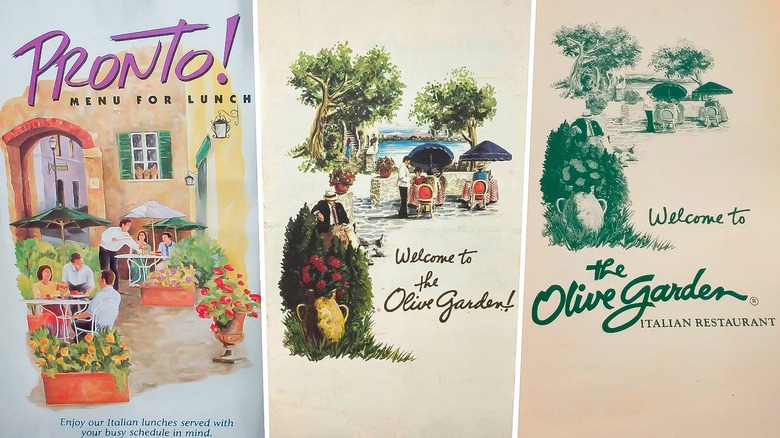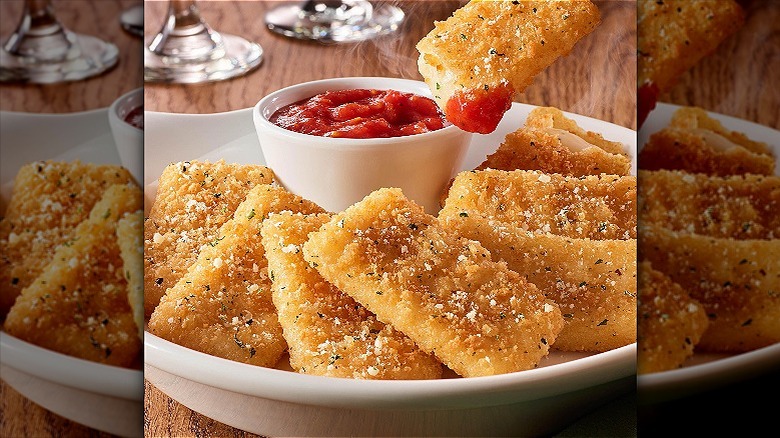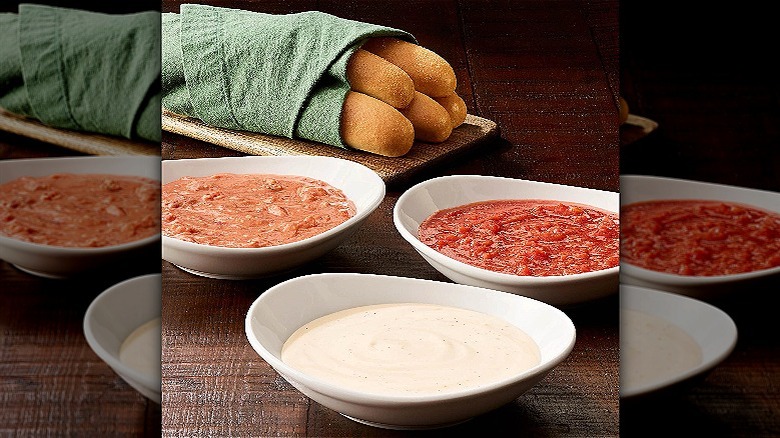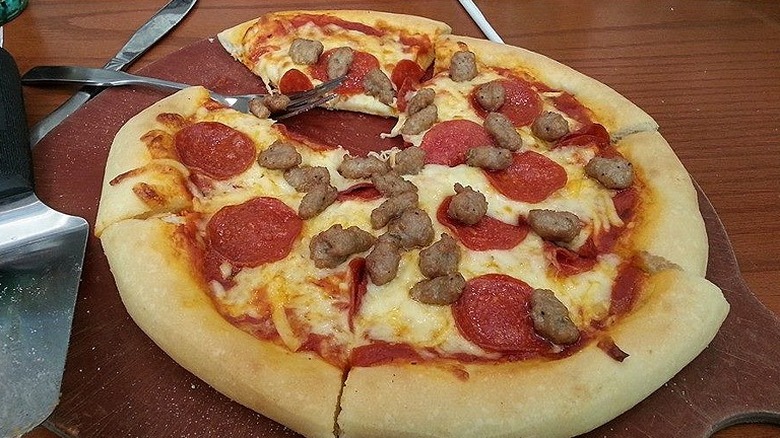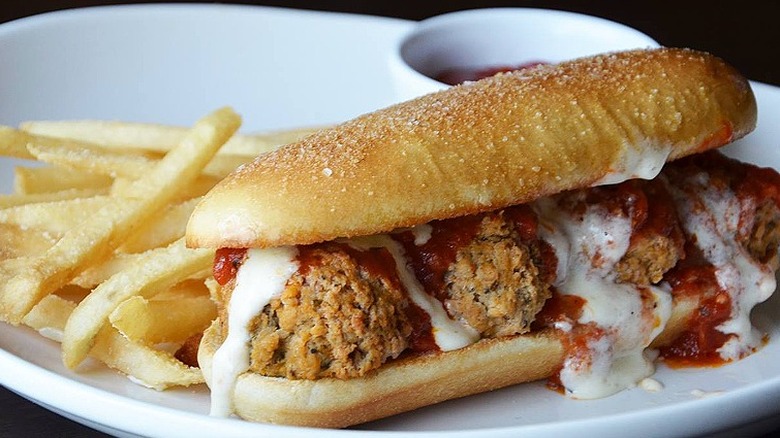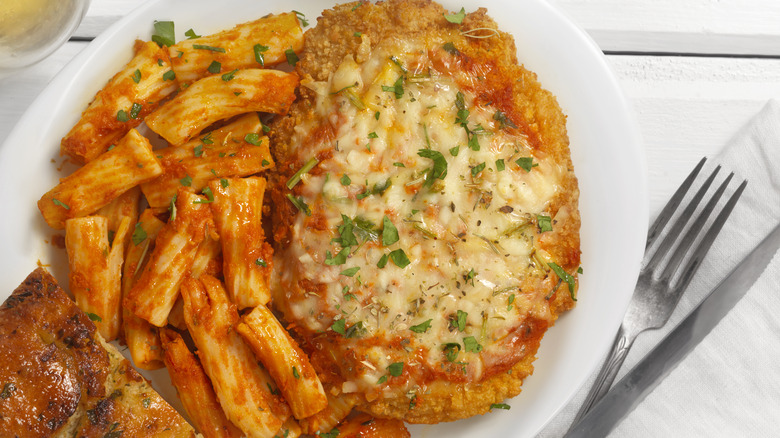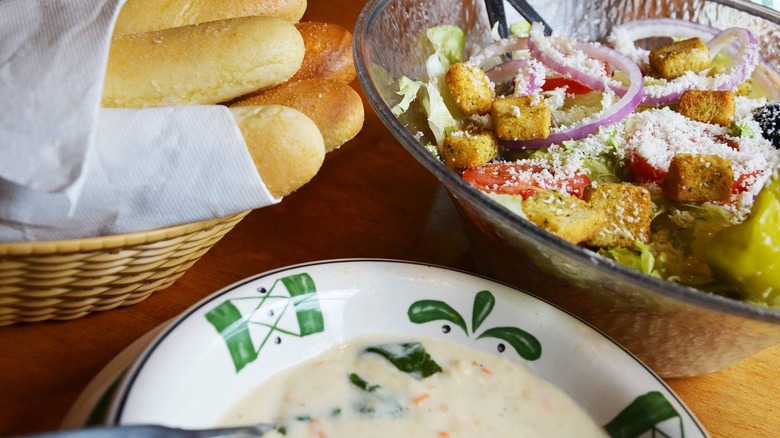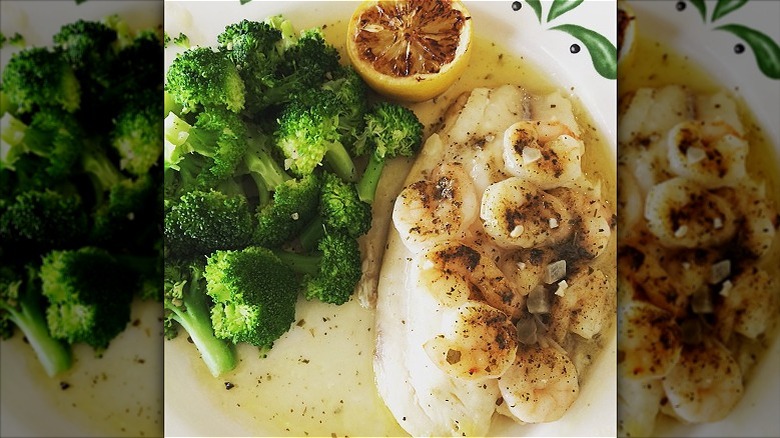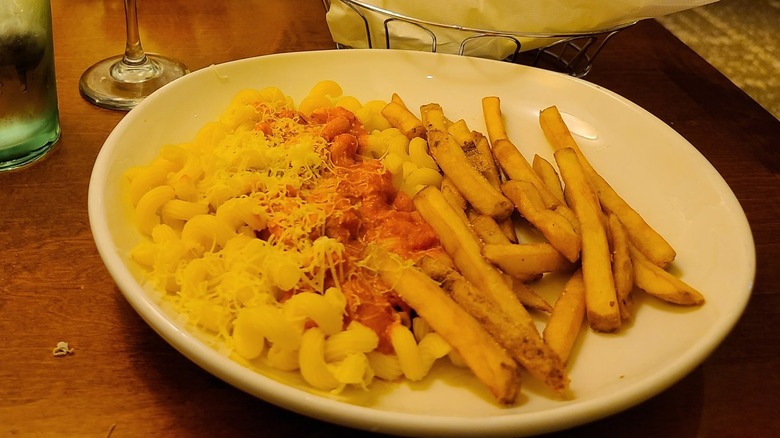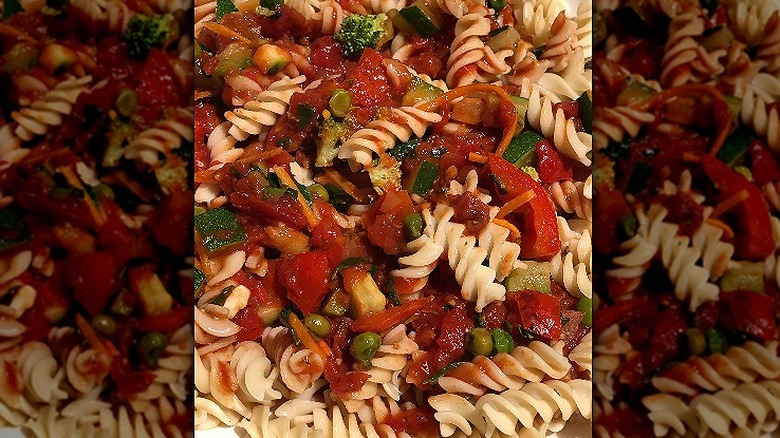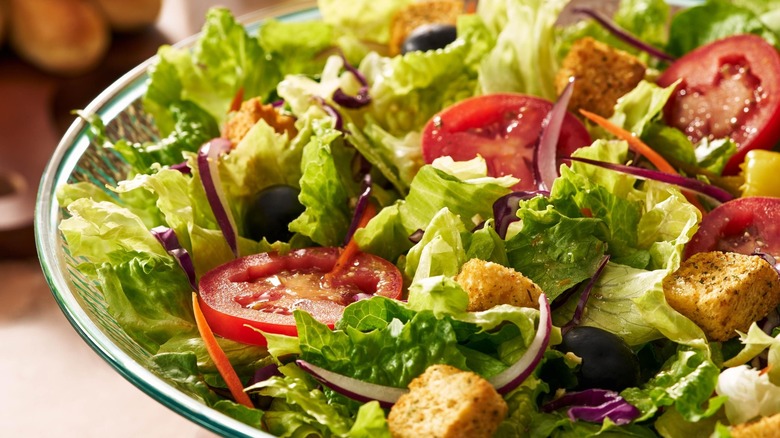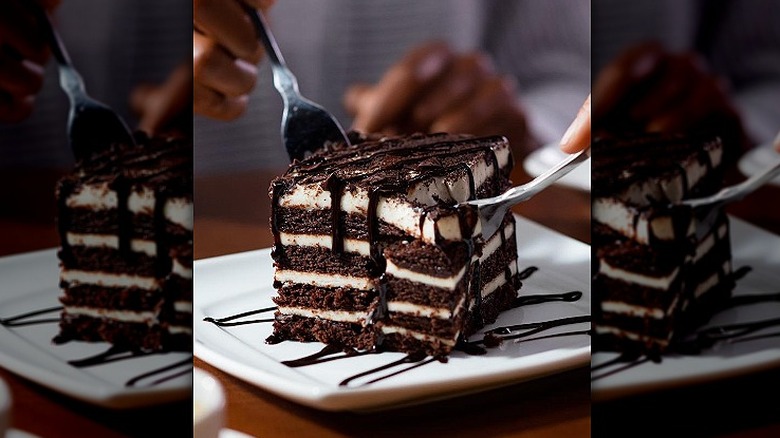The Evolution Of The Olive Garden Menu Over The Years
Since its humble beginnings in Orlando, Florida, in 1982, the Olive Garden has hit the ground running, becoming one of the most beloved Italian restaurants in the country, with over 900 locations in 52 states and territories. Its appeal goes far beyond the endless salad and breadsticks. The menu is affordable, portions abundant, and there is something for almost everyone.
Over its years in business, this menu has changed substantially, redefining the brand and Americans' perceptions of what authentic Italian food looks like, for better or worse. While some of its most popular items have stayed the course, many dishes have fallen by the wayside, either underperforming or failing to maintain the interest of diners.
Perhaps the biggest key to the success of the Olive Garden franchise has been the degree to which it has been able to accommodate the tastes of its clientele and adapt to an ever-volatile restaurant industry. Let us take a closer look at the evolution of the Olive Garden menu over the years.
Appetizers
At the beginning of the menu are tantalizing appetizers to open your palate. When looking at the current menu offerings of appetizers at Olive Garden, it seems like the fryer is getting quite a workout. In fact, besides their meatballs and the ever-present spinach and artichoke dip that appears to be the one menu item to have withstood the test of time, all of their appetizers are a permutation of something that is battered and fried, from mozzarella to calamari to ravioli.
But this wasn't always the case. Some of its earlier menus included more traditional Italian appetizers, like stuffed mushrooms, stuffed shrimp, shrimp scampi, and even a mussels di Napoli dish for the more adventurous palate. The menu also featured a selection of flatbreads, such as Caprese, grilled chicken, pepperoni and sausage, Mediterranean, a bruschetta, and something similar to Mexican queso called a Smoked Mozzarella Fonduta, which was served with breadstick crostini, which we presume were crostini made from leftover breadsticks.
In 2014, Darden Restaurants Inc., the parent company of the Olive Garden, announced a menu overhaul with some experimental items, including the Parmesan Olive Fritta, bite-sized fried olive stuffed cheese, Polenta Shrimp alla Greca, sautéed shrimp served over polenta with a tapenade like sauce, and something called Spicy Calabrian Wings. We will hazard a guess that olives were a tough sell, as none of these items became instant sensations.
The dipping sauce
We aren't sure exactly when the dipping sauce became a staple on the Olive Garden menu. A vintage menu we discovered from the early 1990s did not list dipping sauces as a distinct category. A tangy marinara dip was served alongside the calamari and fried ravioli but not as an accompaniment to the breadsticks. In every other vintage menu we discovered, dipping sauces were listed as a distinct item, beginning with marinara and alfredo.
Sometime in the early 2000s, the five-cheese marinara dipping sauce was added. In the 2014 menu relaunch, a gorgonzola dipping sauce was introduced, which may have been too bold for most people. The menu now offers four dipping sauces: Alfredo, five-cheese marinara, marinara, and meat.
What we found somewhat odd, although unsurprising, is that these are the identical names of the homemade sauces offered as toppings for the create-your-own pasta menu. Essentially, they are the same thing sold under a different name for different purposes. At least the price of a pint of each is identical regardless of if you buy it packaged as "dipping sauce" or just "sauce." Our guess is that at some point, diners began asking for a side of marinara sauce to dip their breadsticks in and rather than giving it away for free, they started charging for it. We suppose that's evidence of good business strategy.
Pizzas
Here is a menu item we wish was still on the menu, pizza. Who does not love pizza? It is the perfect food. And yet, it was not perfect enough to make it for the long haul on the Olive Garden menu. Believe it or not, in the 1990s, the Olive Garden offered a rather extensive pizza menu with flavors like Meaty Italian, Chicken Alfredo, Spicy Sausage & Peppers, and Roma Garden.
These were advertised as a hand-stretched hearth-baked pizza that tasted like the ever-present breadsticks and was served with alfredo and marinara dipping sauces. This may be a clue that the pizza crust was fashioned from the same dough as the breadsticks. Diners could also create their own pizza, starting with a three-cheese pizza (which three kinds of cheese were not specified) and toppings, including pepperoni, sausage, ham, mushrooms, onions, bell pepper blend, black olives, and artichokes.
We are not sure why these did not stick, although we wonder if they just became too labor-intensive to keep up with. Also, considering some of its food is delivered frozen and a lot of its food, like its pasta, is cooked ahead of time, it's conceivable that there was no way to fit pizza into a business model relying upon pre-manufactured food.
Sandwiches
About the same time pizza appeared on the menu, in the 1990s, sandwiches were added. These sandwiches were served on grilled focaccia bread and accompanied by Italian-seasoned fries, which are not particularly authentic, but sound delicious. Options included an Italian Club, a Chicken Caesar Sandwich, the Turkey & Provolone, a Chicken Parmigiana Sandwich, and the Italian Meatball Sandwich. These could be paired with a cup of soup or garden salad for an additional cost.
In the early 2000s, a few more sandwiches were added to the offerings of sandwich and flatbread combos available with your choice of soup or house salad. These included an Italiano Burger and a Smashed Meatball Sandwich. Half portions were also available for the Chicken Parmigiana and Italian Meatball sandwich flavors. As late as 2014, the Smashed Chicken Meatball Sandwich with roasted bell peppers and mozzarella on a focaccia bun was a part of Darden Restaurants Inc.'s menu reboot, along with Antipasti Italian meats and cheeses and a Roasted Tomato Caprese salad with kale.
Sandwiches are nowhere to be found on the menu today. Knowing how labor-intensive sandwiches can be to assemble, we cannot say we are surprised to see these are gone. Also, we blame kale for the demise of the classic Caprese salad. That's a crime against fresh mozzarella and tomatoes and a horrible accompaniment to fresh basil.
Veal
We were surprised to see that in samples of vintage menus from the 1990s, veal was included in the entrée section of the menu. Veal Picatta, Parmigiana, and Marsala were available with a side vegetable of the day and a side pasta of your choice. The veal was advertised as "naturally raised," presumably in line with already burgeoning concerns over animal welfare associated with veal being served in restaurants.
Concerns over veal stem beyond the uneasiness many feel over knowing that veal is made from calves no older than 18 weeks. These animals are also purported to be confined in crates and restrained to minimize the use of their muscles, improving the texture of the meat. And some rumors suggest that the animals are fed a diet primarily of processed formula rather than mother's milk to keep the color of the calf flesh whitish.
While meat producers have made a concerted effort to combat the public perception of the mistreatment of calves being raised for veal, it remains somewhat of a controversial meat to include on a restaurant menu, which makes its exclusion on the current Olive Garden menu unsurprising.
More diverse non-pasta entrées
If you peruse vintage menus, you can see that earlier iterations of the Olive Garden had much more diverse and elaborate entrée items that required a more expanded list of ingredients and a somewhat more sophisticated set of skills from the culinary team. In the 1990s, recipes such as Grilled Swordfish and Crab Alfredo rounded out the seafood menu.
In the 2000s, more options were added, including Pork Milanese, Parmesan Crusted Tilapia, Chianti Braised Short Ribs, Venetian Apricot Chicken, and Chicken Marsala. And with the 2014 expanded menu re-launch, items like Crab Topped Chicken, Salmon Bruschetta, Pappardelle Pescatore, Mediterranean Grilled Trout, and Parmesan Crusted Filet appeared ever so briefly.
While the number of entrées on the current menu at Olive Garden may seem to have expanded, if you look closely, there are a lot of permutations of the same combination of ingredients put together differently. The proteins primarily include chicken, shrimp, and meatballs, with one salmon, a sirloin steak offering, and an eggplant parmigiana.
The rest are baked or sautéed versions of pasta dishes with marinara, alfredo, meat, and five-cheese sauces. You can still get the Tour of Italy, which consists of Chicken Parmigiana, Lasagna Classico, and Fettuccine Alfredo, or create your own pasta fantasy. Again, this makes sense from a cost/benefit perspective for a business trying to streamline profits, but a clear example of how menus have had to become more simplistic to stay competitive.
Addition of the lunch menu
During the 2014 menu expansion, Olive Garden launched its "Lunch Experience," a reduced-price menu designed for the working individual to get in and out quickly. This menu, which was offered until 4 pm Monday through Friday, was implemented with additional training for staff on service protocols to expedite the entire dining experience.
The menu consisted of the Tuscan Trio Combinations, which offered diners the signature salad with breadsticks, a choice of soup, and the option of a salad topping, small pasta bowl, or Italian small plate. There was also a Sandwich and Flatbread Combination, served with soup or salad, and a number of smaller-sized pasta dishes at roughly half the price of their entrée counterparts.
The lunch menu, though somewhat smaller, persists today. Monday through Friday from 11 a.m. to 3 p.m., guests can get a quick soup, salad, and breadsticks lunch or a pint-sized pasta dish. For comparison, the lunch Chicken Parmigiana costs $10.99 at our local Olive Garden, while the entrée version costs $19.49. We also noted that some locations indicated that lunch menus were "currently unavailable," so we recommend checking before you visit a particular Olive Garden to ensure it can accommodate you.
Lighter fare items
In the 2000s, a Lighter Fare menu of entrée items under 575 calories was added, presumably to accommodate the preferences of more health-conscious diners. These included a handful of options such as Herb-Grilled Salmon, Garlic Rosemary Chicken, Baked Tilapia with Shrimp, and Citrus Chicken Sorrento.
With the menu expansion in 2014, two more items were added, a 6-ounce Center Cut Filet Mignon and a Chicken Abruzzi, which was a chicken stew with vegetables, cannellini beans, and kale in a savory broth. While the menu no longer offers low-calorie options, it now has nutrition information readily available for all menu items within the U.S., except those in Hawaii.
The information provided is based on menu items currently available, may not include any specials, and cannot accommodate individual variations based on substitutions, regional or seasonal availability of ingredients, or the "handcrafted nature" of its menu items. That said, it is a fairly extensive and thorough nutritional guide allowing consumers to select their meals mindfully based on individual dietary needs.
Expanded children's menu
Children's menus are standard in most restaurants. The earliest iteration of a children's menu at Olive Garden appeared in the 1990s, where they offered a modest selection of three child portion items — spaghetti, classic lasagna, and ravioli. Its menu offerings and accompanying activities to keep kids occupied during their meals have expanded markedly. The Kids Meals — for children under 12 now include 11 entrée selections, such as pizza, chicken fingers, macaroni and cheese, rotini which has a choice of sauce, and a pint-size alfredo dinner. Children's menu items do not include unlimited soup or salad.
The menus feature a motley crew of characters known as Ollie & Friends. Ollie the Olive, Gina the Grape, Bene Breadstick, Tonya Tomato, and Ricky Ravioli will entertain your kiddos with crayons to color, fun puzzles to solve, stickers, and stories so mom and dad can have a relatively peaceful meal out. Its attention to creating a family-friendly environment has landed the Olive Garden on several lists for the most kid-friendly restaurants to dine out in the U.S.
Gluten-sensitive diet menu
It may seem counterintuitive to equate an Italian restaurant that specializes in breadsticks and pasta with a gluten-sensitive diet menu. However, Olive Garden understands that accommodating a wider swath of the population, including those with food allergies, is crucial. This is good for marketing, good for business, and great for customers. That said, there are some things for those with gluten sensitivities to know when dining at the Olive Garden.
The Olive Garden cannot prevent cross-contamination due to the shared nature of its kitchen. While processes have been established to alert kitchen staff to change their gloves and kitchen utensils before handling a gluten-free order, there is no designated gluten-free kitchen. Additionally, its fryers are shared, meaning anything you order that is fried, like french fries, will come in contact with items containing gluten.
Also, while the gluten-free brown rice pasta used is cooked and held separately from the regular pasta, Olive Garden acknowledges that it has not undergone necessary chemical analysis or implemented protocols congruent with FDA requirements to meet the FDA's definition of "gluten-free," nor can it guarantee that ingredients on the gluten-sensitive diet menu have not come in contact with gluten at the facility in which they were manufactured. With that, if you have a severe gluten allergy or Celiac disease, it may be advisable to avoid ordering off the gluten-sensitive diet menu out of caution if you are highly sensitive.
Vegan and vegetarian diet menu
In keeping with its attempts at disclosing nutritional information of all kinds, the Olive Garden has also made a concerted effort to accommodate those following vegan and vegetarian diets. Its list of vegan and vegetarian menu items applies to all locations within the U.S. except Hawaii. It notes that this information is based upon currently available resources from purveyors of ingredients for its dishes. It also mentions that its kitchen is not designed to be animal-free, and therefore cross-contamination can occur.
For transparency, this menu defines vegetarian as free of meat, stock, gelatin, or animal rennet. Vegan is outlined as free of meat, stock, gelatin, animal rennet, and any other ingredient derived from animals, including honey. It also has designations for what items contain eggs and which contain dairy, which is helpful for those who either have allergies to eggs or dairy or those who observe lacto-ovo vegetarianism. As a side note, there is also a menu online listing all items that may contain pork or alcohol, which is helpful for those of the Muslim or Jewish faiths, those who may be allergic to either, or those needing to eat foods that have been prepared without any alcohol in them for health reasons.
Desserts
Ending a meal with a sweet treat is a must, particularly a rich meal. The evolution of the dessert menu has been rather interesting. Three items have been on the menu since at least the 1990s, based on vintage menus we discovered: Tiramisu, cheesecake, and a mousse pie or cake of some ilk. Other menu items have come and gone, particularly some classic Italian-style desserts.
Early menus included a Zuppa Inglese, a rum-soaked sponge cake layered with custard and topped with whipped cream. There was also a Zabaglione, a custard usually made from eggs, sugar, and marsala wine, with this iteration containing Amaretto liqueur and fresh strawberries. By the 2000s, the menu became cake dominated with lemon cream, Black Tie Mousse, chocolate mousse, and white chocolate raspberry cheesecake added. Zeppoli, which are little Italian donuts, were also added.
In the 2014 menu expansion, an experimental American Italian hybrid franken dessert was added, a Salted Caramel Tiramisu. This was only available for a limited time. Today's menu is streamlined, with only six options. These include the tiramisu, Black Tie Mousse cake, Zeppoli (called Warm Italian Donuts), a strawberry cream cake, Sicilian cheesecake with strawberry topping, and a very American Chocolate Brownie Lasagna. This may have to do with the fact that none of its desserts are made in-house but rather arrive at each location frozen, so the offerings must reheat well.
